Yue Xie
Palpation Alters Auditory Pain Expressions with Gender-Specific Variations in Robopatients
Jun 13, 2025Abstract:Diagnostic errors remain a major cause of preventable deaths, particularly in resource-limited regions. Medical training simulators, including robopatients, play a vital role in reducing these errors by mimicking real patients for procedural training such as palpation. However, generating multimodal feedback, especially auditory pain expressions, remains challenging due to the complex relationship between palpation behavior and sound. The high-dimensional nature of pain sounds makes exploration challenging with conventional methods. This study introduces a novel experimental paradigm for pain expressivity in robopatients where they dynamically generate auditory pain expressions in response to palpation force, by co-optimizing human feedback using machine learning. Using Proximal Policy Optimization (PPO), a reinforcement learning (RL) technique optimized for continuous adaptation, our robot iteratively refines pain sounds based on real-time human feedback. This robot initializes randomized pain responses to palpation forces, and the RL agent learns to adjust these sounds to align with human preferences. The results demonstrated that the system adapts to an individual's palpation forces and sound preferences and captures a broad spectrum of pain intensity, from mild discomfort to acute distress, through RL-guided exploration of the auditory pain space. The study further showed that pain sound perception exhibits saturation at lower forces with gender specific thresholds. These findings highlight the system's potential to enhance abdominal palpation training by offering a controllable and immersive simulation platform.
Auditory-Tactile Congruence for Synthesis of Adaptive Pain Expressions in RoboPatients
Jun 13, 2025Abstract:Misdiagnosis can lead to delayed treatments and harm. Robotic patients offer a controlled way to train and evaluate clinicians in rare, subtle, or complex cases, reducing diagnostic errors. We present RoboPatient, a medical robotic simulator aimed at multimodal pain synthesis based on haptic and auditory feedback during palpation-based training scenarios. The robopatient functions as an adaptive intermediary, capable of synthesizing plausible pain expressions vocal and facial in response to tactile stimuli generated during palpation. Using an abdominal phantom, robopatient captures and processes haptic input via an internal palpation-to-pain mapping model. To evaluate perceptual congruence between palpation and the corresponding auditory output, we conducted a study involving 7680 trials across 20 participants, where they evaluated pain intensity through sound. Results show that amplitude and pitch significantly influence agreement with the robot's pain expressions, irrespective of pain sounds. Stronger palpation forces elicited stronger agreement, aligning with psychophysical patterns. The study revealed two key dimensions: pitch and amplitude are central to how people perceive pain sounds, with pitch being the most influential cue. These acoustic features shape how well the sound matches the applied force during palpation, impacting perceived realism. This approach lays the groundwork for high-fidelity robotic patients in clinical education and diagnostic simulation.
The Morphology-Control Trade-Off: Insights into Soft Robotic Efficiency
Mar 20, 2025Abstract:Soft robotics holds transformative potential for enabling adaptive and adaptable systems in dynamic environments. However, the interplay between morphological and control complexities and their collective impact on task performance remains poorly understood. Therefore, in this study, we investigate these trade-offs across tasks of differing difficulty levels using four well-used morphological complexity metrics and control complexity measured by FLOPs. We investigate how these factors jointly influence task performance by utilizing the evolutionary robot experiments. Results show that optimal performance depends on the alignment between morphology and control: simpler morphologies and lightweight controllers suffice for easier tasks, while harder tasks demand higher complexities in both dimensions. In addition, a clear trade-off between morphological and control complexities that achieve the same task performance can be observed. Moreover, we also propose a sensitivity analysis to expose the task-specific contributions of individual morphological metrics. Our study establishes a framework for investigating the relationships between morphology, control, and task performance, advancing the development of task-specific robotic designs that balance computational efficiency with adaptability. This study contributes to the practical application of soft robotics in real-world scenarios by providing actionable insights.
Displacement-Sparse Neural Optimal Transport
Feb 03, 2025Abstract:Optimal Transport (OT) theory seeks to determine the map $T:X \to Y$ that transports a source measure $P$ to a target measure $Q$, minimizing the cost $c(\mathbf{x}, T(\mathbf{x}))$ between $\mathbf{x}$ and its image $T(\mathbf{x})$. Building upon the Input Convex Neural Network OT solver and incorporating the concept of displacement-sparse maps, we introduce a sparsity penalty into the minimax Wasserstein formulation, promote sparsity in displacement vectors $\Delta(\mathbf{x}) := T(\mathbf{x}) - \mathbf{x}$, and enhance the interpretability of the resulting map. However, increasing sparsity often reduces feasibility, causing $T_{\#}(P)$ to deviate more significantly from the target measure. In low-dimensional settings, we propose a heuristic framework to balance the trade-off between sparsity and feasibility by dynamically adjusting the sparsity intensity parameter during training. For high-dimensional settings, we directly constrain the dimensionality of displacement vectors by enforcing $\dim(\Delta(\mathbf{x})) \leq l$, where $l < d$ for $X \subseteq \mathbb{R}^d$. Among maps satisfying this constraint, we aim to identify the most feasible one. This goal can be effectively achieved by adapting our low-dimensional heuristic framework without resorting to dimensionality reduction. We validate our method on both synthesized sc-RNA and real 4i cell perturbation datasets, demonstrating improvements over existing methods.
A 'MAP' to find high-performing soft robot designs: Traversing complex design spaces using MAP-elites and Topology Optimization
Jul 10, 2024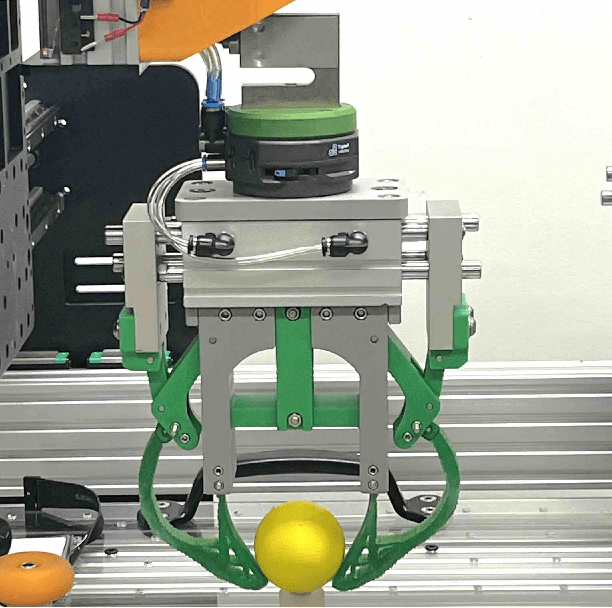
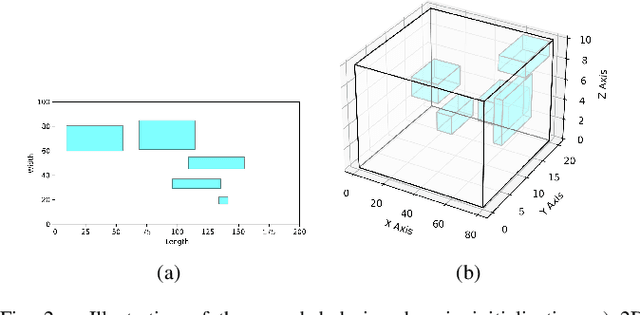

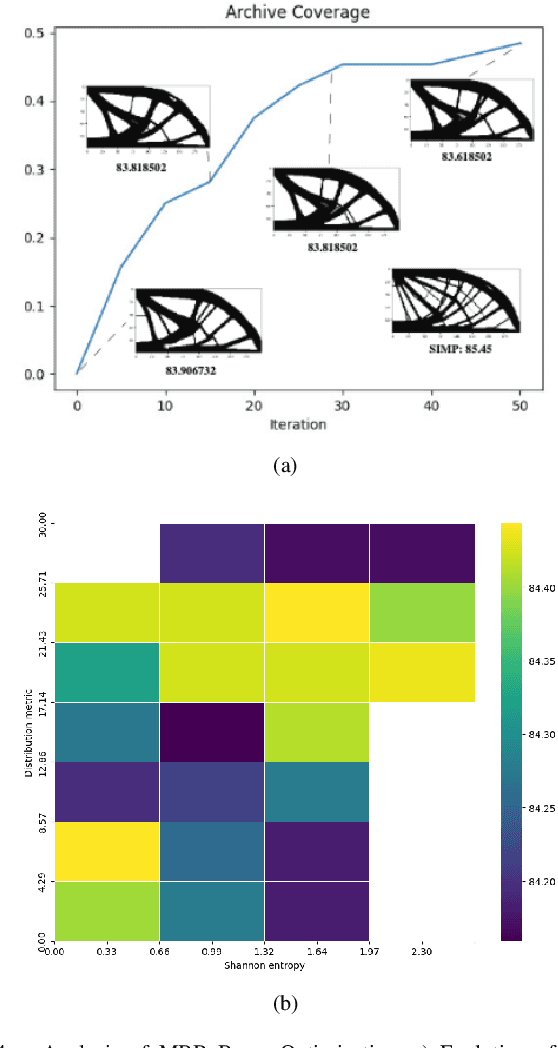
Abstract:Soft robotics has emerged as the standard solution for grasping deformable objects, and has proven invaluable for mobile robotic exploration in extreme environments. However, despite this growth, there are no widely adopted computational design tools that produce quality, manufacturable designs. To advance beyond the diminishing returns of heuristic bio-inspiration, the field needs efficient tools to explore the complex, non-linear design spaces present in soft robotics, and find novel high-performing designs. In this work, we investigate a hierarchical design optimization methodology which combines the strengths of topology optimization and quality diversity optimization to generate diverse and high-performance soft robots by evolving the design domain. The method embeds variably sized void regions within the design domain and evolves their size and position, to facilitating a richer exploration of the design space and find a diverse set of high-performing soft robots. We demonstrate its efficacy on both benchmark topology optimization problems and soft robotic design problems, and show the method enhances grasp performance when applied to soft grippers. Our method provides a new framework to design parts in complex design domains, both soft and rigid.
Stochastic First-Order Methods with Non-smooth and Non-Euclidean Proximal Terms for Nonconvex High-Dimensional Stochastic Optimization
Jun 27, 2024Abstract:When the nonconvex problem is complicated by stochasticity, the sample complexity of stochastic first-order methods may depend linearly on the problem dimension, which is undesirable for large-scale problems. In this work, we propose dimension-insensitive stochastic first-order methods (DISFOMs) to address nonconvex optimization with expected-valued objective function. Our algorithms allow for non-Euclidean and non-smooth distance functions as the proximal terms. Under mild assumptions, we show that DISFOM using minibatches to estimate the gradient enjoys sample complexity of $ \mathcal{O} ( (\log d) / \epsilon^4 ) $ to obtain an $\epsilon$-stationary point. Furthermore, we prove that DISFOM employing variance reduction can sharpen this bound to $\mathcal{O} ( (\log d)^{2/3}/\epsilon^{10/3} )$, which perhaps leads to the best-known sample complexity result in terms of $d$. We provide two choices of the non-smooth distance functions, both of which allow for closed-form solutions to the proximal step. Numerical experiments are conducted to illustrate the dimension insensitive property of the proposed frameworks.
VEnvision3D: A Synthetic Perception Dataset for 3D Multi-Task Model Research
Mar 05, 2024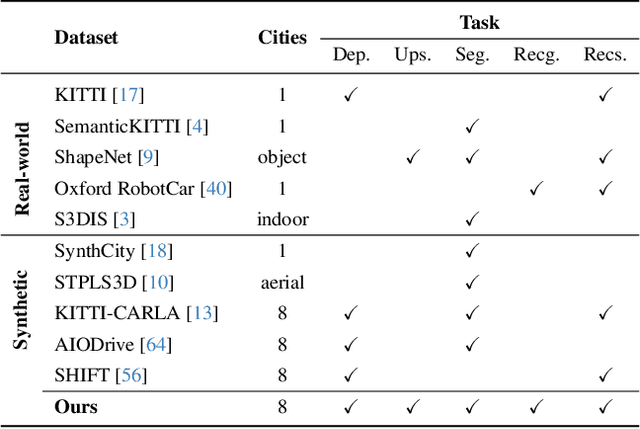
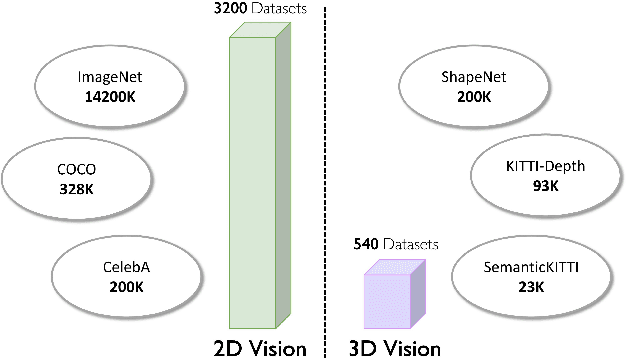

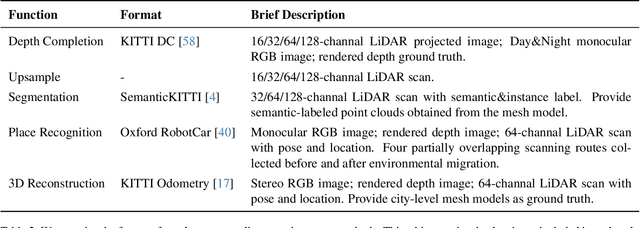
Abstract:Developing a unified multi-task foundation model has become a critical challenge in computer vision research. In the current field of 3D computer vision, most datasets only focus on single task, which complicates the concurrent training requirements of various downstream tasks. In this paper, we introduce VEnvision3D, a large 3D synthetic perception dataset for multi-task learning, including depth completion, segmentation, upsampling, place recognition, and 3D reconstruction. Since the data for each task is collected in the same environmental domain, sub-tasks are inherently aligned in terms of the utilized data. Therefore, such a unique attribute can assist in exploring the potential for the multi-task model and even the foundation model without separate training methods. Meanwhile, capitalizing on the advantage of virtual environments being freely editable, we implement some novel settings such as simulating temporal changes in the environment and sampling point clouds on model surfaces. These characteristics enable us to present several new benchmarks. We also perform extensive studies on multi-task end-to-end models, revealing new observations, challenges, and opportunities for future research. Our dataset and code will be open-sourced upon acceptance.
Fin-QD: A Computational Design Framework for Soft Grippers: Integrating MAP-Elites and High-fidelity FEM
Nov 21, 2023Abstract:Computational design can excite the full potential of soft robotics that has the drawbacks of being highly nonlinear from material, structure, and contact. Up to date, enthusiastic research interests have been demonstrated for individual soft fingers, but the frame design space (how each soft finger is assembled) remains largely unexplored. Computationally design remains challenging for the finger-based soft gripper to grip across multiple geometrical-distinct object types successfully. Including the design space for the gripper frame can bring huge difficulties for conventional optimisation algorithms and fitness calculation methods due to the exponential growth of high-dimensional design space. This work proposes an automated computational design optimisation framework that generates gripper diversity to individually grasp geometrically distinct object types based on a quality-diversity approach. This work first discusses a significantly large design space (28 design parameters) for a finger-based soft gripper, including the rarely-explored design space of finger arrangement that is converted to various configurations to arrange individual soft fingers. Then, a contact-based Finite Element Modelling (FEM) is proposed in SOFA to output high-fidelity grasping data for fitness evaluation and feature measurements. Finally, diverse gripper designs are obtained from the framework while considering features such as the volume and workspace of grippers. This work bridges the gap of computationally exploring the vast design space of finger-based soft grippers while grasping large geometrically distinct object types with a simple control scheme.
A Study of Fitness Gains in Evolving Finite State Machines
Oct 20, 2023
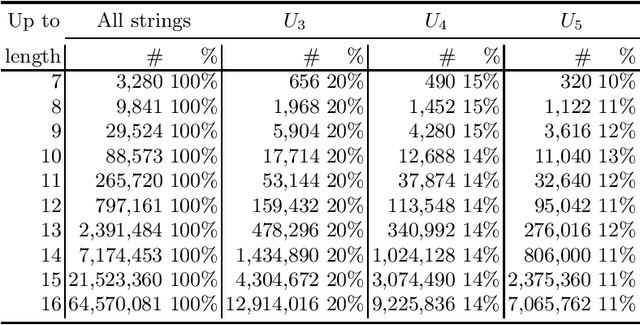
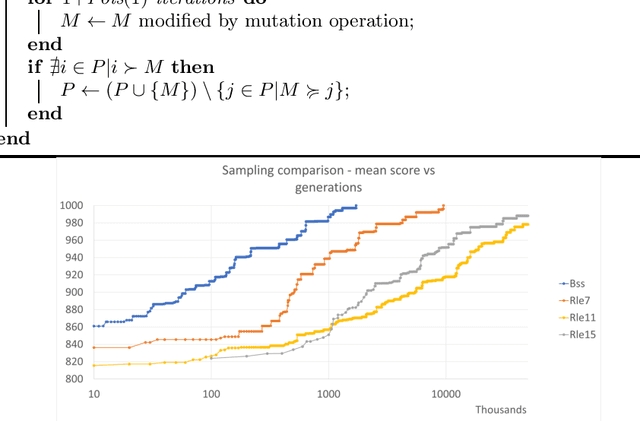
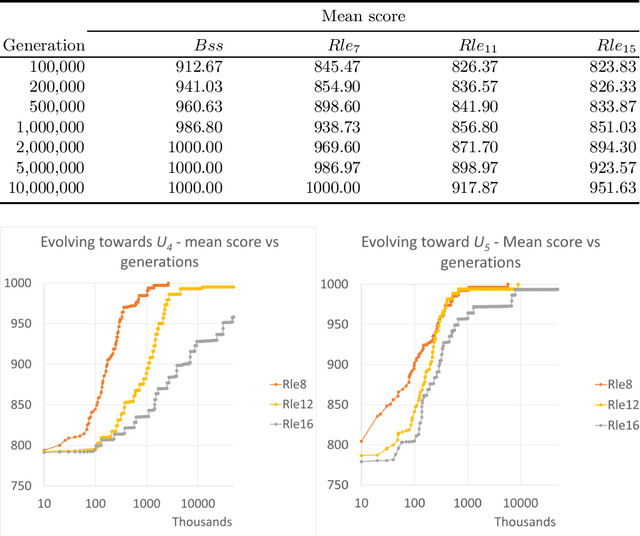
Abstract:Among the wide variety of evolutionary computing models, Finite State Machines (FSMs) have several attractions for fundamental research. They are easy to understand in concept and can be visualised clearly in simple cases. They have a ready fitness criterion through their relationship with Regular Languages. They have also been shown to be tractably evolvable, even up to exhibiting evidence of open-ended evolution in specific scenarios. In addition to theoretical attraction, they also have industrial applications, as a paradigm of both automated and user-initiated control. Improving the understanding of the factors affecting FSM evolution has relevance to both computer science and practical optimisation of control. We investigate an evolutionary scenario of FSMs adapting to recognise one of a family of Regular Languages by categorising positive and negative samples, while also being under a counteracting selection pressure that favours fewer states. The results appear to indicate that longer strings provided as samples reduce the speed of fitness gain, when fitness is measured against a fixed number of sample strings. We draw the inference that additional information from longer strings is not sufficient to compensate for sparser coverage of the combinatorial space of positive and negative sample strings.
Prior Information based Decomposition and Reconstruction Learning for Micro-Expression Recognition
Mar 03, 2023


Abstract:Micro-expression recognition (MER) draws intensive research interest as micro-expressions (MEs) can infer genuine emotions. Prior information can guide the model to learn discriminative ME features effectively. However, most works focus on researching the general models with a stronger representation ability to adaptively aggregate ME movement information in a holistic way, which may ignore the prior information and properties of MEs. To solve this issue, driven by the prior information that the category of ME can be inferred by the relationship between the actions of facial different components, this work designs a novel model that can conform to this prior information and learn ME movement features in an interpretable way. Specifically, this paper proposes a Decomposition and Reconstruction-based Graph Representation Learning (DeRe-GRL) model to effectively learn high-level ME features. DeRe-GRL includes two modules: Action Decomposition Module (ADM) and Relation Reconstruction Module (RRM), where ADM learns action features of facial key components and RRM explores the relationship between these action features. Based on facial key components, ADM divides the geometric movement features extracted by the graph model-based backbone into several sub-features, and learns the map matrix to map these sub-features into multiple action features; then, RRM learns weights to weight all action features to build the relationship between action features. The experimental results demonstrate the effectiveness of the proposed modules, and the proposed method achieves competitive performance.
 Add to Chrome
Add to Chrome Add to Firefox
Add to Firefox Add to Edge
Add to Edge